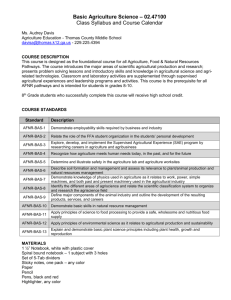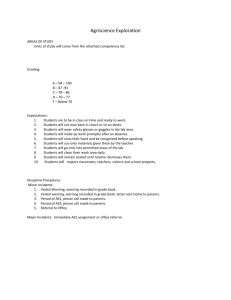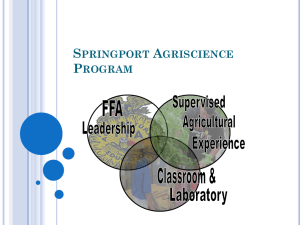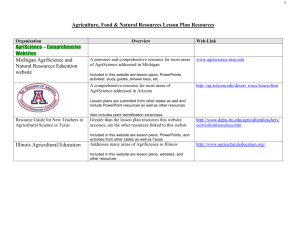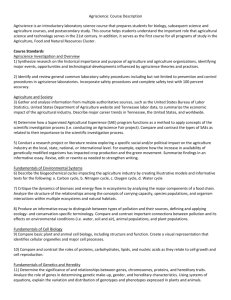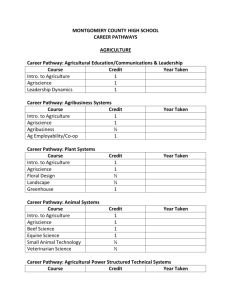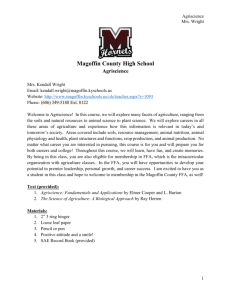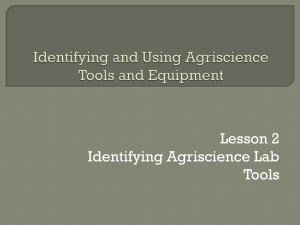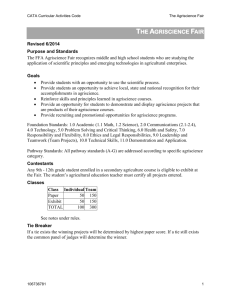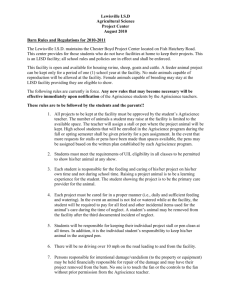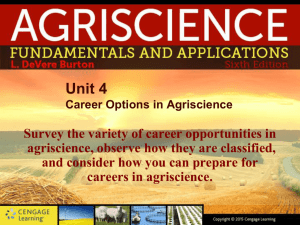I. Animal Systems
advertisement
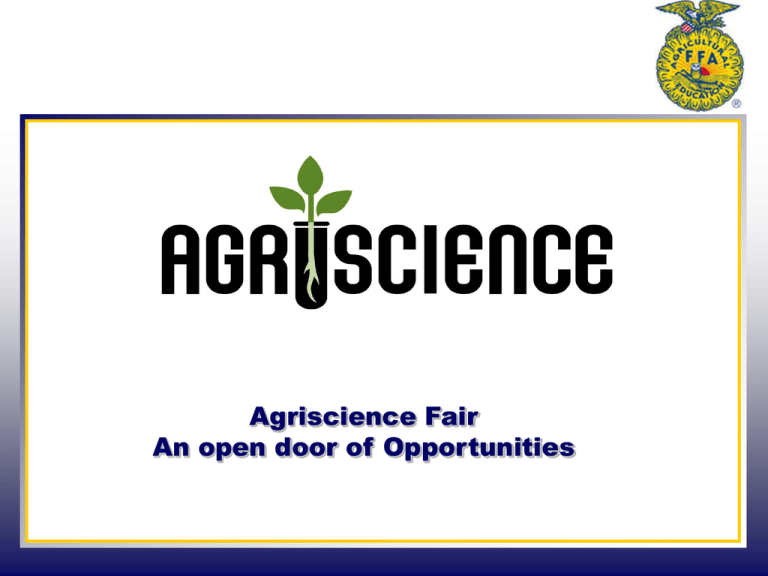
Agriscience Fair An open door of Opportunities Goals & Objectives The National FFA Agriscience Fair recognizes middle and high school students who are studying the application of scientific principles and emerging technologies in agricultural enterprises. Participation begins at the local chapter level and progresses to the state and national levels. Areas of participation closely mirror those of the International Science and Engineering Fair but reflect an agricultural theme. Goals & Objectives Provide students with an opportunity to use the scientific process Provide students an opportunity to achieve local, state and national recognition for their accomplishments Reinforce skills and principles learned in agriscience courses Provide an opportunity for students to demonstrate and display agriscience projects Provide recruiting and promotional opportunities for agriscience programs Creating a Project Getting Started • Pick a subject area • Narrow the scope • Consider you SAE Create a Hypothesis • Translate the problem into a question Test the Hypothesis • • • • • • Research Redefine problem Revisit the hypothesis Experiment Form conclusion Report results Agriscience Fair Project Research • Primary research • Interviews • Exploratory experiments • Surveys • Secondary research • • • • Books Journals/newspapers Internet Peer reviewed articles • Reporting results • Charts • Graphs Final Written Report • • • • • • • • • • Title page Table of contents Abstract Introduction Review of Literature Materials & Methods Results Discussion & Conclusion Acknowledgements Literature Cited National Agriscience Fair Categories I. Animal Systems The study of animal systems, including life processes, health, nutrition, genetics, management and processing, through the study of small animals, aquaculture, livestock, dairy, horses and/or poultry. Examples: • Compare nutrient levels on animal growth • Research new disease control mechanisms • Effects of estrous synchronization on ovulation • Compare effect of thawing temperatures on livestock semen • Effects of growth hormone on meat/milk production National Agriscience Fair Categories II. Environmental Services/ Natural Resource Systems The study of systems, instruments and technology used in waste management; the study of the management of soil, water, wildlife, forests and air as natural resources and their influence on the environment. Examples: • Effect agricultural chemicals on water quality • Effects of cropping practices on wildlife populations • Compare water movements through different soil types National Agriscience Fair Categories III. Food Products and Processing Systems The study of product development, quality assurance, food safety, production, sales and service, regulation and compliance and food service within the food science industry. Examples: • Effects of packaging techniques on food spoilage rates • Resistance of organic fruits to common diseases • Determining chemical energy stored in foods • Control of molds on bakery products National Agriscience Fair Categories IV. Plant Systems The study of plant life cycles, classifications, functions, structures, reproduction, media and nutrients, as well as growth and cultural practices, through the study of crops, turf grass, trees an shrubs and/or ornamental plants. Examples: • Determine rates of transpiration in plants • Effects of heavy metals such as cadmium on edible plants • Compare GMO and conventional seed/plant growth under various conditions • Effects of lunar climate and soil condition on plant growth • Compare plant growth of hydroponics and conventional methods National Agriscience Fair Categories V. Power, Structural and Technical Systems The study of agricultural equipment, power systems, alternative fuel sources and precision technology, as well as woodworking, metalworking, welding and project planning for agricultural structures. Examples: • Develop alternate energy source engines • Create minimum energy use structures • Compare properties of various alternative insulation products • Investigation of light/wind/water energy sources National Agriscience Fair Categories VI. Social Systems The study of human behavior and the interaction of individuals in and to society, including agricultural education, agribusiness economic, agricultural communication, agricultural leadership and other social science applications in agriculture, food and natural resources. Examples: • Investigate perceptions of community members towards alternative agricultural practices • Determine the impact of local/state/national safety programs upon accident rates in agriculture/natural resource occupations • Determine the economical effects of local/state/national legislation impacting agriculture/natural resources Helpful Tips Managing Outcomes • Do not change your hypothesis • Do not omit for or against evidence • If outcome is different than the hypothesis, suggest why • State what could/should happen next • Displaying your results • Be creative and organized • Do not clutter • Use relevant photos and simple, correct captions – 50 words or less Remember: • • • Display is 10% of total project Keep it simple Posters are great for displaying information Title Use sentence case Introduction All text should be readable from a minimum of 3 feet away. Results Results should be mostly illustrations with captions. MAKE SURE ALL PHOTOS, GRAPHS, AND TABLES HAVE CAPTIONS. Results Discussion Bullet the discussion as much as you can. Results should be mostly illustrations with captions. MAKE SURE ALL PHOTOS, GRAPHS, AND TABLES HAVE CAPTIONS. Methods Methods can be boring and long. Try to shorten it up by bulleting as much as possible Literature Cited Just like in a paper, if you used reference literature or cited literature in your text you must cite it. Acknowledgements A necessary evil, especially if your research was funded. Thankfully the font can be ridiculously tiny Logos should go here if you have to use logos Helpful Tips Interviewing Tips • • • • • Practice Prepare Relax Smile Firm Handshake Dress to Impress State Participation States may conduct a qualifying competition Six categories with four divisions each • Individual (7-9), Team (7-9) • Individual (10-12), Team (10-12) • Total of 24 different areas States may enter one project in each of the 24 areas if they conduct a state qualifying competition. National Participation Individuals/Teams may not No two entries from a state may compete with each other at the national level Students may only participate in one entry per year (as an individual or a team) Project display and interview at the National FFA Convention compete in the same category and division once they have place in the top 3 in that respective area. National Awards All participants receive recognition and a pin (gold, silver, or bronze) Cash awards for 1st, 2nd and 3rd place will be dependent upon available funds. Important Dates Forms due with postmark date no later than July 15 • • • • • • • • Application Hazardous Material Waiver Non-human Vertebrate Endorsement Human Vertebrate Endorsement Research Expense Checklist for Adult Sponsor/Safety Assessment Research Plan Approval Complete Written Report National Convention, Mid-October Extra Information Visit the National FFA Website • www.ffa.org/agrisciencefair Contact your State FFA Staff member or the National FFA Education Specialist at agriscience@ffa.org or 317-802-4402.
